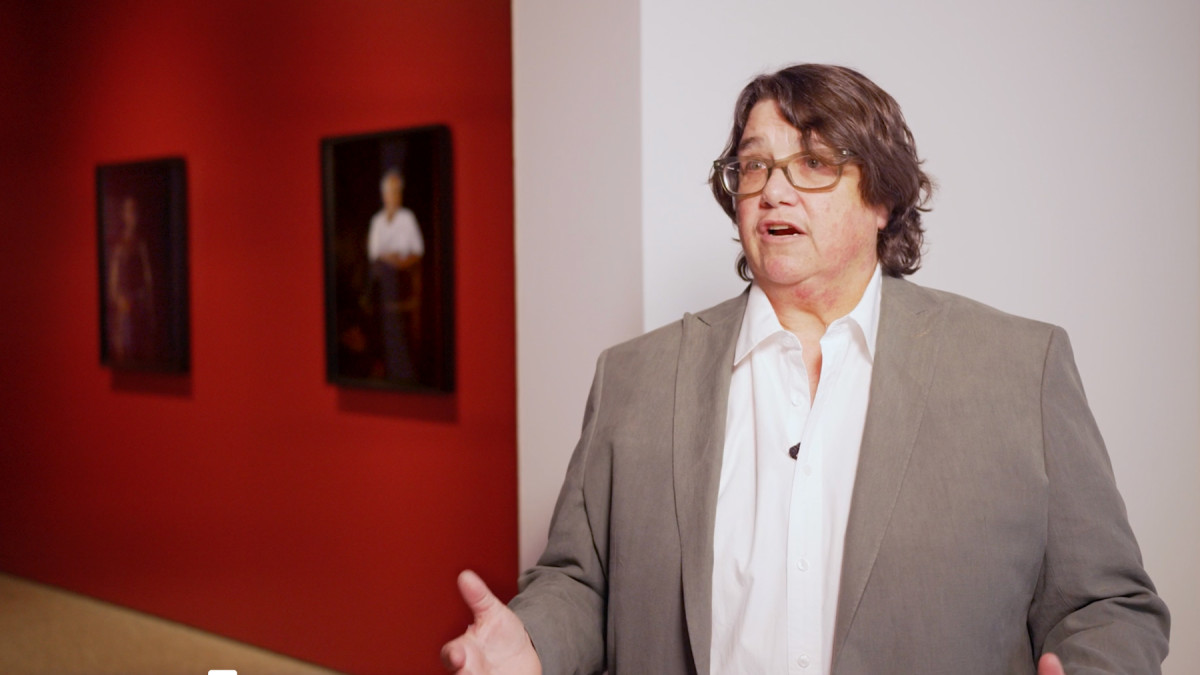Cathy (bed self-portrait)
1987 - Photography (Photography)
Catherine Opie
Catherine Opie’s candid photograph Cathy (bed Self-portrait) (1987) shows the artist atop a bed wearing a negligee and a dildo; the latter is attached to a whip that she holds in her teeth. Opie is known for her honest portraits of diverse individuals, from LGBT people to football players, and the self-portrait has also been a long-standing and important part of her practice. Instead of hiding her sexuality and interest in sadomasochism, Opie wears it proudly. Photographed at a time when artistic freedoms were generally under attack in America, Opie’s full-frontal reveal is a kind of revolutionary moment, signifying that expression cannot and will not be suppressed.
Since the 1990s, Catherine Opie has been recognized for her use of documentary photography to address issues of community and queerness, and the ways in which identity is shaped by architecture. Particularly resonant during the Culture Wars of the 1980s and early 1990s—a time in which the religious right tried to impose itself as a political force and cultural censor—Opie’s photographs privilege the representation of specific communities, whether the LGBT, teenagers, surfers, football players, or her group of friends who engage in sexual role playing, tattooing, and piercing.
Colors:
Other related works, blended automatically

© » ROYAL ACADEMY
Catherine Opie
Video: Catherine Opie on photographing leading British artists | Blog | Royal Academy of Arts Catherine Opie in the RA Collection Gallery Video: Catherine Opie on photographing leading British artists Read more Become a Friend Video: Catherine Opie on photographing leading British artists Published 8 September 2023 Catherine Opie discusses her portraits of David Hockney, Anish Kapoor, Gillian Wearing, Isaac Julien and Lynette Yiadom-Boakye, featured in our free display in the Collection Gallery...

© » KADIST
Walead Beshty
2012Constructed out of metal or glass to mirror the size of FedEx shipping boxes, and to fit securely inside, Walead Beshty’s FedEx works are then shipped, accruing cracks, chips, scrapes, and bruises along the way to their destination...

© » KADIST
Juliana Huxtable
2017Herculine’s Prophecy by Juliana Huxtable features a kneeling demon-figure on what appears to be a screen-print, placed on a wooden table, which has then been photographed and digitally altered to appear like a book cover, with a title and subtitle across the top, and a poem written across the bottom...

© » KADIST
Walead Beshty
2011Constructed out of metal or glass to mirror the size of FedEx shipping boxes, and to fit securely inside, Walead Beshty’s FedEx works are then shipped, accruing cracks, chips, scrapes, and bruises along the way to their destination...

© » KADIST
Gimhongsok
2007To explore the boundaries between artwork and audience, Gimhongsok created a series of sculptural performances in which a person wearing an animal costume poses in the gallery...

© » KADIST
Ian Wallace
1986Wallace says of his Heroes in the Street series, “The street is the site, metaphorically as well as in actuality, of all the forces of society and economics imploded upon the individual, who, moving within the dense forest of symbols of the modern city, can achieve the status of the heroic.” The hero in Study for my Heroes in the Street (Stan) is the photoconceptual artist Stan Douglas, who is depicted here (and also included in the Kadist Collection) as an archetypal figure restlessly drifting the streets of the modern world...

© » KADIST
James Welling
2006Welling employs simple materials like crumpled aluminum foil, wrinkled fabric and pastry dough and directly exposes them as photograms, playing with the image in the process of revealing it...

© » KADIST
Yto Barrada
2007This photograph is part of the series titled “Iris Tingitana project” (2007) focusing on the disappearance of the iris...

© » KADIST
Du Zhenjun
2010The Tower of Babel is an installation of large-format photographs that forces the audience to occupy a central position through its monumental scale...

© » KADIST
Yto Barrada
2004In this photographic series, Yto Barrada was interested in the logos of the buses that travel between North Africa and Europe...

© » KADIST
Du Zhenjun
2010The Tower of Babel is an installation of large-format photographs that forces the audience to occupy a central position through its monumental scale...

© » KADIST
Shahzia Sikander
2010The Last Post was inspired by Sikander’s ongoing interest in the colonial history of the sub-continent and the British opium trade with China...

© » KADIST
Lynn Hershman Leeson
2016Tania Libre is a film by Lynn Hershman Leeson centered around renowned artist Tania Bruguera and her experience as a political artist and activist under the repressive government of her native Cuba...

© » KADIST
Sharon Lockhart
2011Visalia Livestock Market, Visalia, California results from Lockhart’s prolonged investigation of an agricultural center and community...

© » KADIST
Rodney Graham
1996Tree on the Former Site of Camera Obscura (1996) belongs to a series of large-scale photographs of trees taken by Graham and depicts a particular species that lives in Northern California...

© » KADIST
Piero Golia
2007Golia’s Untitled 3 is an installation in which a mechanical device is programmed to shoot clay pigeons that are thrown up in front of a white wall...

© » KADIST
Wolfgang Tillmans
2017Wolfgang Tillmans initiated the ongoing series Faltenwurf in 1989, representing compositions of unused clothing, with special attention paid to the ways in which they drape and fold...

© » KADIST
Du Zhenjun
2010The Tower of Babel is an installation of large-format photographs that forces the audience to occupy a central position through its monumental scale...

© » KADIST
Qing Zhang
2006603 Football Field presents a soccer game played inside a small student apartment in Shanghai...

